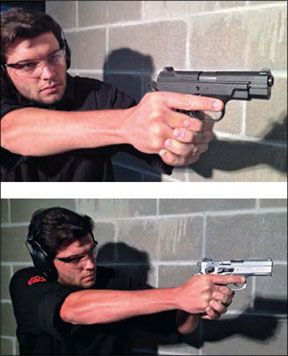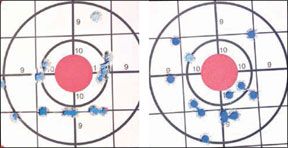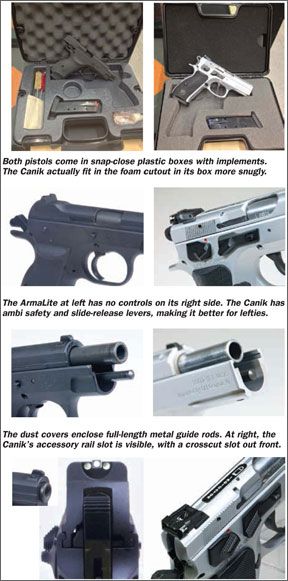We recently had the opportunity to shoot and thoroughly test two pistols imported from Turkey, and they were alike in ways other than sharing a home country — the two towns where the handguns are made sit about 523 km apart on the south side of the Black Sea. The Canik55 Stingray-C 9mm Luger, $370, imported by Century International Arms, is made in Samsun by Canik55, a police- and military-arms builder established in 1998. This DA/SA semi-auto is a CZ-75 clone made of steel with a hard-chrome finish, and it tips the scale at a hefty 38 ounces unloaded weight and 45 ounces loaded weight with 16 rounds aboard. It stands 5.25 inches tall and is 7.1 inches long.

The AR-24 Pistol Compact 24K-13 9mm Luger, $550, is made by Sarsilmaz in D zce and is imported by ArmaLite of Geneseo, Illinois. It is a hoss as well, weighing in at 36.2 ounces unloaded and 42.4 ounces loaded. The AR-24 is 7.5 inches long and stands 5.2 inches tall and carries 14 rounds as its total payload.
The pair also had traits that separated them. Cosmetically, they were night and day. The hard-chrome finish of the Stingray practically glowed in the dark, but it also wore very well, showing no dings or scratches by the end of our test program. The AR-24, in contrast, has a military-grade manganese phosphate and heat-cured epoxy exterior for outstanding corrosion resistance and a low-glare dark-grey finish. The ArmaLite pistol comes in four variations, the largest being the AR-24, a full-size recoil-operated modified-Browning locked-breech 9mm. Our test gun, the AR-24K, is a compact version of the same gun. Tactical Custom versions have windage- and elevation-adjustable rear sights and checkering instead of grooves on the frontstrap and backstrap. Canik55 produces several lines of pistols, including the MKEK, Shark, Piranha, S-FC, Dolphin, and TP series, along with the Stingrays. The Stingrays are chambered in 9mm Luger (Para) and come in full-size versions (up to 19-round magazines) and compact Stingray-C models in both chrome- and black-chrome plated finishes.
To collect bench-accuracy data, we set up at Tactical Firearms in Katy, Texas (TacticalFirearms.us) and fired five-shot groups at 15 yards using the supplied open sights. On the bench, we used sandbags to support the guns and the shooter’s arms. We recorded velocities using a PACT Professional XP with infrared screens with the first screen set 12 feet from the muzzle. Our 9mm Luger ammunition samples were Winchester USA 115-grain full metal jackets, Federal American Eagle 147-grain full-metal-jacket flat points, and Hornady Steel Match 125-grain HAP hollowpoints. Here is how we judged each gun when they were compared head to head.
The Packages
The AR-24 pistol arrived in a sturdy plastic shell containing a formed-plastic insert, two magazines with red-colored followers, an owner’s manual, cleaning equipment, two fired cartridge cases, a locking device, and a manual. Our Product Coordination Editor scored two additional magazines (No. PM2413, $30 each) for a total of four. The Stingray came in a Canik55-branded plastic pistol case with two Mec-Gar 15-round blued steel magazines, manual, cleaning kit, a mini-screwdriver key fob for easy sight adjustment, rear sight hex wrench for drift adjustment, and a lock. We were surprised at the magazine capacity because Century says the Mec-Gars are supposed to be 10- or 13-rounders. Both manuals were excellent, two of the best we’ve seen. Our Team Said: These were two well-rounded pistol packages. Toss up.
Physical Descriptions
As we noted above, the two pistols are similar in size, weight, height, and capacity. But those weights connote strong construction. ArmaLite uses CNC-machined steel forgings for its slide, frame, and barrel, and we found the pistol to be tightly fitted. Its machined surfaces were flat and straight, and we didn’t detect any machine marks. We were likewise impressed with the machining and fitting on the Canik. The guns have the same maximum width (1.5 inches), though the AR-24’s widest point is across the palm swell of the grip and the Stingray is widest across the ambi safeties. The barrels are nearly the same length (3.5 inches for the Canik, 3.89 inches for the ArmaLite), and the Canik had a slightly longer sight radius (5.6 inches to 5.25 inches) because of how the LPA adjustable rear sight sat behind the dovetail.
Our Team Said: We can’t imagine carrying either gun since both are around 2.75 pounds, and there are plenty of 9mm pistols that weigh half that.
Grips & Controls
Our shooters said palm swells on the AR-24’s checkered rubber grip panels offered good contact with the gun, better than the Canik’s traditionally contoured checkered-plastic panels. Also, the AR-24’s grip was cut more deeply and an upswept, longer tang allowed a deep, high grip that we preferred over the Stingray’s. Also, the top of the AR-24’s rubber grip had a shelf that offered a good place for the trigger thumb (either hand) to rest on.

With the magazines in place, we found very little difference in the strap measurements. The backstraps were the same length, and the frontstrap on the Canik was 0.15 inch longer than the AR-24’s, not enough to make a difference in hand comfort or room. Grip circumferences were likewise close (5.8 inches for the AR-24 versus 5.9 inches for the Canik), but the grip shape was notably better on the ArmaLite, we felt. It was squarer than the Canik, which got its circumference from being longer front to back. In both cases, mild grooves in the straps didn’t seem to help gripping much.
On the Canik, the lack of texture on the backstrap and the slick brushed-chrome finish allow the grip to move around if the shooter has wet or oily hands. That’s less of an issue with the AR-24, in our opinion. On either pistol, the full-size, thick grips offer a suitable amount of purchase for a large hand, but shooters with smaller hands or short fingers should hone in on how the grip feels and make sure they can reach the trigger at the double-action trigger position before buying.
The frame-mounted safety switches on both guns were reminiscent of CZ placement and operation. On the ArmaLite, the safety was a squarish-profile lever that was on Safe when up (covering a red dot), and down for Fire. The Canik’s lever profile was more rounded, and our thumbs didn’t catch on it as well as the AR-24’s. When the Canik’s lever was on Safe, a yellow dot under the lever was exposed. The Canik added fully ambidextrous controls for the safety and slide release — a big plus for lefties. Slide-release levers on both pistols actually released the slides for our female shooters, who sometimes can’t press down hard enough on the lever to get the slide to jump forward. They have to use two hands, one to retract the slide slightly and the other to manipulate the lever. Not an issue on these guns, we found. Female shooters had a fairly hard time retracting the slides on both pistols, but the slicker Canik gave them more trouble.
Also, both guns’ magazine releases can be switched to the other side of the gun, another checkmark for southpaws. Magazines ejected smartly from both guns. The Stingray-C has a sizable button located on the top of the slide, and if a round is in the chamber, this piece tilts up in the front, providing visual and tactile cues that a round is in the chamber. Also, the Stingray-C has an accessory rail on the bottom of the frame that accepts a laser or flashlight. Our Team Said: We preferred the AR-24’s natural point, which we think is mainly a reflection of the grip housing’s shape and the contours and materials of the grip panels.

Accuracy Overall, the ArmaLite shot better groups than the Canik55, with a computed overall average of 2.0 inches to the Canik’s 2.2-inch average. However, the Canik shot the best average group of the test. The AR-24 showed a half-inch average group size edge with the Winchester USA 115-gr. FMJ Q4172s, 2.3 inches to 2.8 inches, and had a 0.4-inch edge with the Hornady Steel Match 125-gr. HAP 90275 load, 1.8 to 2.2 inches. But the Stingray-C stung the AR-24 with the Federal American Eagle AE9FP 147-gr. FMJ Flat Points, 1.6 inches to 1.9 inches.
Also at 15 yards, we shot from low ready with a full AR-24 (14) and double-tapped a Birchwood Casey BB-SI target bullseye until the gun was empty. The gun pointed naturally for us, and a combination of the weight and grip angle made riding the recoil natural and fast, allowing us to put three shots in the 10-ring and 11 shots in the 9-ring with the Hornady Steel Match 125-grain load. The Canik preferred the AE load off the bench, and it shot as well offhand, with six 10s and ten 9s.
Our Team Said: It’s fair to say that with the right ammunition, both guns are 4-inch-or-better shooters at 15 yards.
Magazines
The Canik’s blued-steel Mec-Gar mags had removable plastic bumper pads to protect the mag bodies, which were staggered double-stack designs that narrowed to single-stack blue-plastic followers. We found it difficult to fit more than 14 rounds in the magazine unless we used a plastic push-down loader to help, but a fifteenth round would fit and function. During our function, accuracy, and chronograph testing of about 300 rounds, we had one malfunction, a failure to feed a Hornady hollowpoint. This is due, we believe, to the well-made magazines feeding into a ramped, fully supported chamber. The same description generally follows for the ArmaLite mags, except they weren’t marked as Mec-Gars, had red followers, and held two fewer rounds. Also, the bumpers on the AR-24 were slightly larger, equalizing the total mag heights.
Our Team Said: The shape of the bumpers on the AR-24 mags finished the grip contour slightly better than the Canik’s.
Operation Both guns have DA/SA operation, and manual safeties, automatic firing pin block safeties (the pistols cannot fire if the trigger isn’t pulled, even if the manual safety is not engaged), and inertial firing pins (even when the manual safety is off and the hammer down on a loaded chamber, the firing pin cannot contact the primer). Also, both have automatic disconnectors to prevent firing unless the slide and barrel are locked together, and both have half-cock positions to help prevent firing if the hammer slips from your grasp as you are cocking it or if pistol is dropped. It’s worth mentioning that the half-cock notch should not be used in lieu of the manual safety.
Neither have grip safeties. However, the safety setup allows for cocked-and-locked carry, which we wouldn’t recommend. That’s no slam on the function of these thumb safeties — just a recognition that we’d prefer a 1911-style grip safety engaged for C&L carry. On both guns, when they are on Safe, the hammer is locked as well as the action. With the safety lever down, the gun is set to Fire. We thought the lever operated smoothly and positively with an appropriate amount of thumb pressure up or down.
After following the directions in the manual to disassemble and lube the pistol, we found the AR-24 to be initially sluggish in operation (weak extraction, failure to go into battery), just as the manual described. But after we extensively dry fired the AR-24 and fed it about 75 rounds of ammo, we noticed no further reliability issues. As we note elsewhere, the Canik suffered one failure to feed in the first 50 rounds, and none after. Our Team Said: Reliability was high with both pistols. Toss up.
Triggers In operation, both work like a traditional DA/SA pistol with an exposed hammer. When you load the pistol and release the slide forward, the trigger moves all the way forward, a span of about 3.1 inches from the deepest part of the backstrap to the middle of the trigger face on the AR-24 and 3.25 inches for the Canik. Some smaller-handed shooters may have trouble getting a positive pull on the trigger as a result. A light pull on either trigger moves it about a half-inch, then stops with the hammer fully retracted. Further pressure moves the trigger to a DA break weight of around 12 pounds overall for both guns, though the Canik’s measurement was 12+ pounds, above what a Lyman digital gauge can show.
When we worked the triggers DA-revolver style, we agreed the final parts of their trigger strokes were reasonably crisp and predictable. In single action mode with the hammer back and the gun on Safe, we could flip down the safety lever and get a nice 4.5-pound break on the AR-24 with a 2.6-inch trigger span, compared to the 6.4-pound, 2.75-inch metrics on the Canik. Our Team Said: The AR-24 had a slightly better, shorter break.
Sights
The AR-24’s front sight base was dovetailed into the frame and locked with a set screw to allow it to be moved and/or replaced. Windage adjustment on the fixed-sight AR-24 should be conducted by loosening the front-sight screw and shifting the front sight slightly in the direction opposite the desired movement of the bullet strike, according to the manual. There were no clicks or reference lines, so adjustments must be made by trial and error. The AR-24’s non-adjustable rear sight was fit to the slide, and any shift of the sight will cause it to protrude on either side of the slide. Moving the front blade was easier.
The Canik’s front blade was pinned into a cut into the top of the slide, making it nonadjustable except by replacement. That’s really no big deal though, because the Canik had a fully adjustable LPA-brand rear sight, which made centering hits much easier. Both guns’ sights showed luminous three-dot patterns, but we thought the glow wasn’t all that strong in either one.
Our Team Said: The Canik’s adjustable rear sight was such a strong winner in this category, we’d strongly consider trying an ArmaLite Tactical Custom upgrade rather than our fixed-sight model. Of course, the TC model is more expensive, $631.
Takedown
On the ArmaLite, ensure the gun and magazine is empty and clear of ammo, then cock the hammer. Put the safety on Safe. Draw the slide to the rear until the dots on the left rear sides of the slide and receiver are aligned one above the other. This positions the slide stop for removal. We found that by holding the slide and receiver of the pistol with the thumb of the right hand through the trigger guard, we could hold the slide in position by placing our fingers above the slide. That left a hand free to press the exposed tip of the slide stop (protruding from the right side of the pistol) into the slide (with a fired case) to start the slide stop out of the receiver to the left side. We had to wiggle the slide stop up and down while pulling it out, but it came free easily. Then, to remove the barrel from the slide, ease the slide spring forward slightly, then pull it upward out of its seat in the slide. The barrel and slide spring came loose easily. Reassemble in reverse order.
Disassembly on the Canik is the same, save for pushing on a tab on the right side magazine release.
Our Team Said: Both pistols were simple to take apart.
The Bottom Line The case for the Canik55 Stingray-C: It comes with a loaded-chamber indicator and a Picatinny rail, which the ArmaLite lacks. Had a +2 edge in capacity as tested. Overall, it shot nearly as well as the ArmaLite with all ammos, and had the best accuracy group of the test. It included adjustable sights. It cost $120 less.
The case for the ArmaLite AR-24 Compact: The AR-24’s rubber grip panels and frame shape made the gun easier to control, and it felt better to our testers. The gun’s fixed sights were regulated closely to desired points of impact with two of the three ammunition choices, so its lacking adjustable sights wasn’t an issue. It was more accurate with two ammo brands tested.
Our Team Said: Both guns are good values. If we could find one for sale, we’d spend our money on the ArmaLite AR-24 Compact.
Written and photographed by Gun Tests staff, using evaluations from Gun Tests team testers.




























